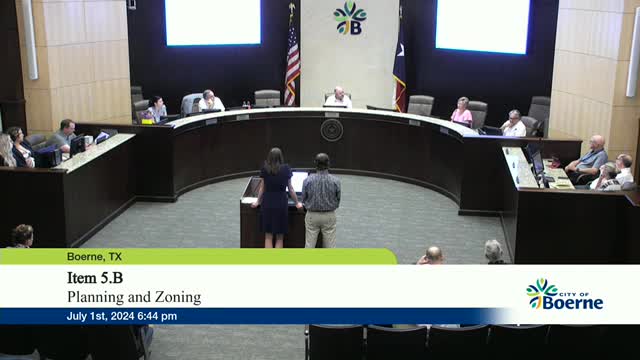Community debates future of historic property development
July 01, 2024 | Boerne, Kendall County, Texas

This article was created by AI summarizing key points discussed. AI makes mistakes, so for full details and context, please refer to the video of the full meeting. Please report any errors so we can fix them. Report an error »

In a recent government meeting, officials grappled with a contentious proposal regarding the development of a property currently housing a high-end rental. The discussion centered on the potential for subdividing the lot to accommodate an additional dwelling, a move that has sparked significant debate among council members.
One official expressed strong reservations about the proposal, emphasizing the importance of adhering to existing zoning standards, which require a minimum lot size of one acre. The official highlighted concerns about public safety, particularly regarding the implications for first responders and residents if accessory dwellings were permitted on smaller lots. \"I'm just having a really hard time swallowing that,\" they stated, reflecting the complexity of balancing development with community safety and historical preservation.
Another council member countered, arguing that the remaining portion of the lot would be effectively undevelopable if restrictions on accessory dwellings and secondary homes were maintained. They pointed out that many properties in the area face similar limitations, suggesting a broader issue with current zoning regulations. The member advocated for the construction of smaller residential homes in infill areas, expressing a preference for such developments over the risk of commercial encroachment that could threaten the historic character of the neighborhood.
The meeting underscored the challenges faced by local governments in navigating development proposals that intersect with community values, safety concerns, and historical preservation. As discussions continue, officials are tasked with finding a solution that respects both the need for housing and the integrity of the community's heritage.
One official expressed strong reservations about the proposal, emphasizing the importance of adhering to existing zoning standards, which require a minimum lot size of one acre. The official highlighted concerns about public safety, particularly regarding the implications for first responders and residents if accessory dwellings were permitted on smaller lots. \"I'm just having a really hard time swallowing that,\" they stated, reflecting the complexity of balancing development with community safety and historical preservation.
Another council member countered, arguing that the remaining portion of the lot would be effectively undevelopable if restrictions on accessory dwellings and secondary homes were maintained. They pointed out that many properties in the area face similar limitations, suggesting a broader issue with current zoning regulations. The member advocated for the construction of smaller residential homes in infill areas, expressing a preference for such developments over the risk of commercial encroachment that could threaten the historic character of the neighborhood.
The meeting underscored the challenges faced by local governments in navigating development proposals that intersect with community values, safety concerns, and historical preservation. As discussions continue, officials are tasked with finding a solution that respects both the need for housing and the integrity of the community's heritage.
View full meeting
This article is based on a recent meeting—watch the full video and explore the complete transcript for deeper insights into the discussion.
View full meeting
